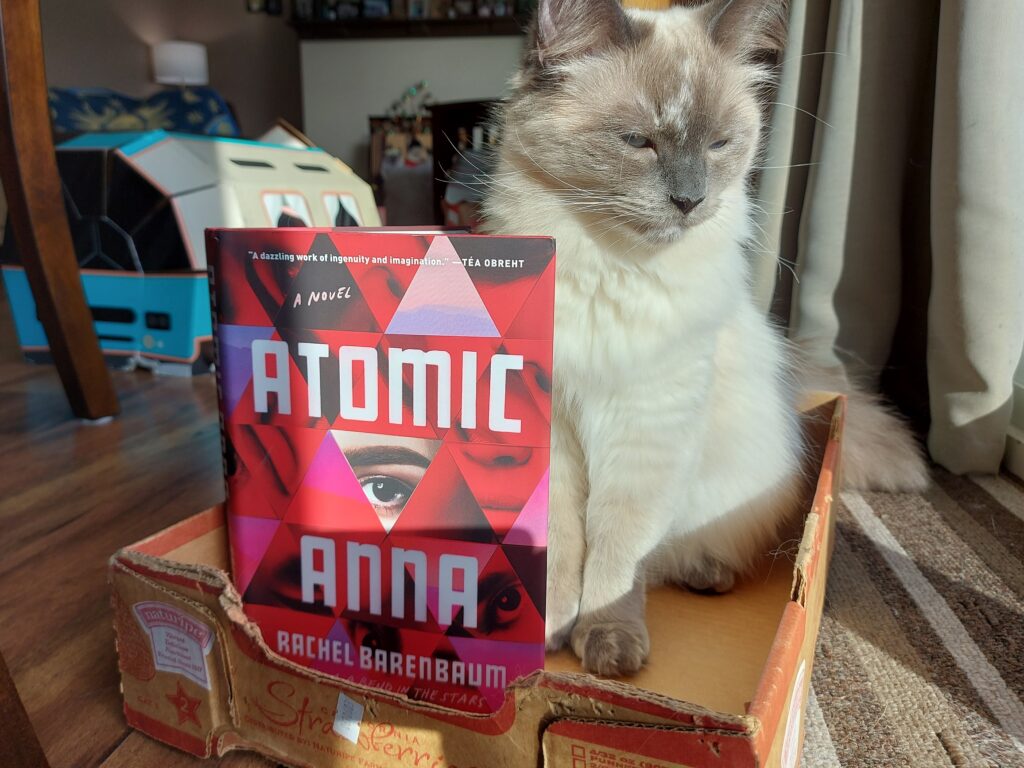Atomic Anna by Rachel Barenbaum

If you are fascinated by stories about time travel, then I think you may enjoy Atomic Anna. I find time travel to be fascinating, and I love debating the ethics of time travel (since it is still a theoretical concept). But Atomic Anna is not merely a story about time travel, it is also a multigenerational story about a family populated by strong, brilliant women. If you are expecting some pulpy sci-fi story, you are not going to find it in Atomic Anna. Atomic Anna is better than that.
It is April 1986, and Reactor No. 4 at Chernobyl has exploded, sending Anna Berkova, who is sleeping in her bed in Pripyat, into the future to December 8, 1992. She finds herself on a snowy mountain outside of a building she will soon realize is the cosmic ray station that her estranged husband secretly started building for her, before she betrayed him by giving their daughter to her best friend Yulia to take to the US. Inside the station she finds a woman bleeding out on the floor. This is her daughter Manya/Molly, who she has not seen since Manya was a baby. With her dying breath, Manya asks Anna to save her own daughter, Anna’s granddaughter, Raisa. And then Anna is sent back to 1986.
Anna is a Russian Jewish scientist who designed Chernobyl and who has spent her life theorizing about time travel. Atomic Anna allows the reader a look behind the Iron Curtain at a country where people are viewed according to their usefulness to the Soviet Union and disposed of when they are no longer useful. Fearing that Gorbachev will blame her – and kill her – for the catastrophe at Chernobyl, Anna escapes from Ukraine and goes to the cosmic ray station with a plan to build a time machine and travel back in time to warn her past self about what will happen at Chernobyl, so that she can save all the people who were killed in the explosion and those who later died from radiation exposure.
Anna quickly realizes that the mechanics of time travel will not allow her to travel to see herself, so she instead travels to Philadelphia where her best friend Yulia is living with Yulia’s husband, Lazar, Molly and a young Raisa. Anna tells Yulia how she has discovered time travel, and she begs Yulia to go back to Russia to warn Anna about Chernobyl. Yulia is quick to believe Anna about the time travel, but she is angry at Anna for wanting to use time travel to save a bunch of strangers instead of saving her own family.
Back in her present timeline, Anna realizes the trip to see Yulia has changed her past. Suddenly, she has letters and photos from Yulia explaining what has happened to Molly and Raisa, and begging Anna to help them. Although Yulia and Lazar mean well, Molly was raised by adoptive parents in whom Soviet values are deeply ingrained. They wanted her to focus on science and math when Molly would rather focus on her art. She is especially drawn to comics and has created a comic called “Atomic Anna”, based on the mother she knows little about. In a fit of rebellion against her parents, Molly leaves home with her criminal boyfriend and her life becomes a repetitious cycle of drug addiction, recovery, and relapse. When Molly ends up in prison, Raisa is put into the foster care system where she is abused and set on the same path as her mother.
Atomic Anna explains the mechanics behind Anna’s time machine, but it went right over my head, so I am not the person to tell you if Anna’s time travel is plausible or not. I was more interested in the generational trauma inflicted by the mothers on the daughters in Anna’s family, and if Anna’s time travelling could even correct this trauma. Anna is faced with a dilemma: should Anna choose her family over the thousands of people who suffered from the Chernobyl explosion? Should she choose the greater good over a couple of individuals? Should she even time travel and change the past when she does not know how it will affect the present and the future? This novel will give you a lot to think about. I enjoyed reading Atomic Anna and I highly recommend it.